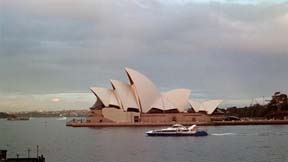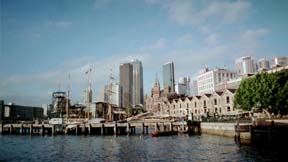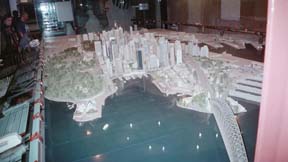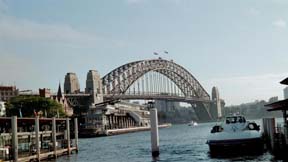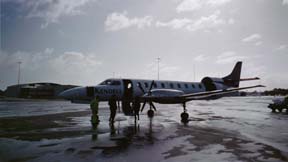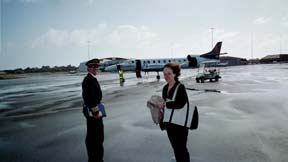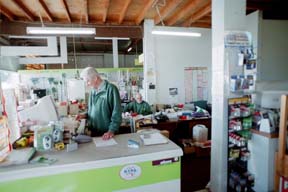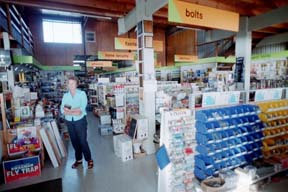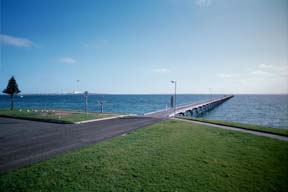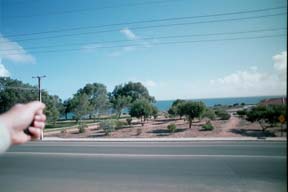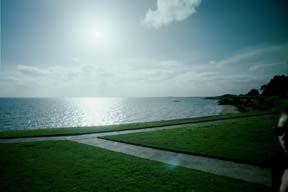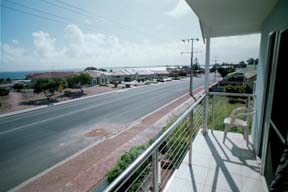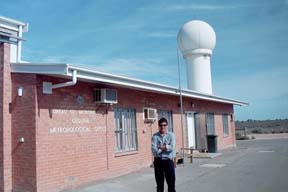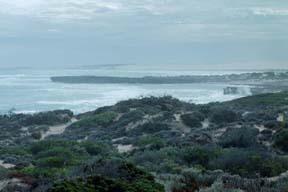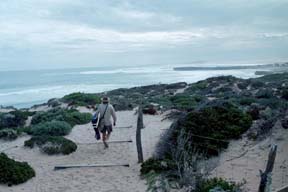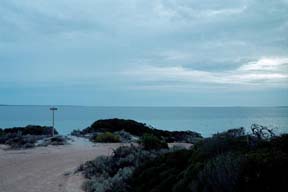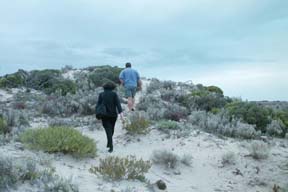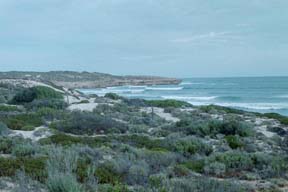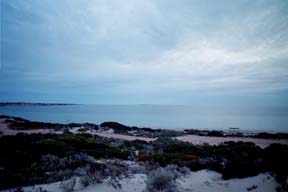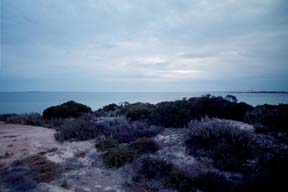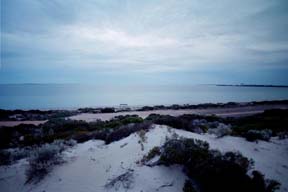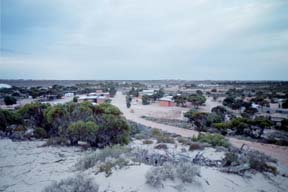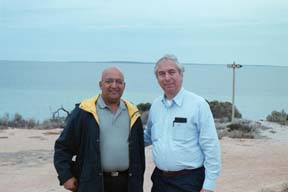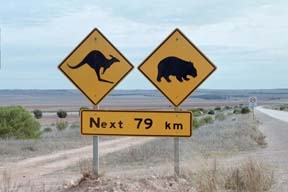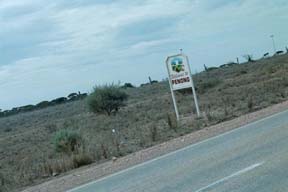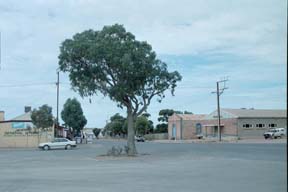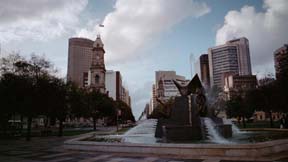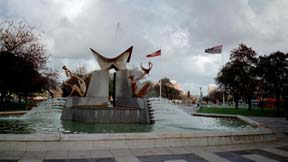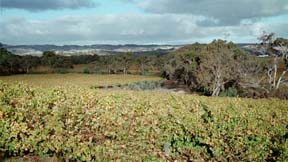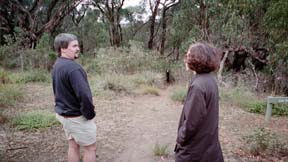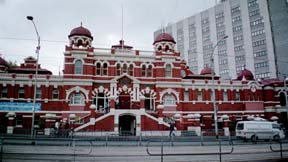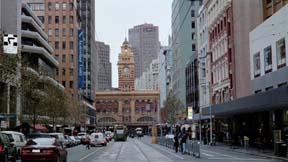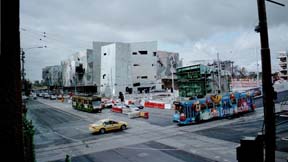Weblog of Trip to Ceduna, Australia
in Preparation for the 2002 Total Solar Eclipse
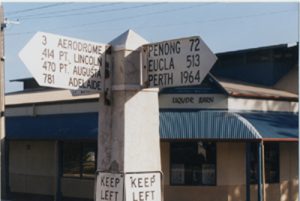
In May 2002 my wife Naomi and I went to Ceduna, Australia to check on arrangements for observing the 2002 total solar eclipse. Here is a Weblog of our trip, including various references. See www.eclipses.info as well. Included are photographs of some of the places that we visited.
Jay Pasachoff, [email protected]
Friday, May 10
Naomi and I flew from Boston to California. This schedule gave us a night to sleep in a real bed before boarding the overnight flight to Australia.
Saturday, May 11
We flew Qantas 108 on its American codeshare out of LAX at 11:45 pm. The Qantas staff was very friendly throughout. The 14h40m flight is so long that we were able to sleep 7 hours; having an empty seat between us helped. Leg room was OK, though not fabulous. The seating is 3-4-3 on the Boeing 747. We brought sandwiches with us, which we were glad to have in the middle of the night, though there was a dinner and a breakfast served, both of which were fine, as well as a snack just before landing, which we found both tiny and unappetizing.
Through a contact on Patrick Poitevin’s Solar Eclipse Mailing List, Dale Ireland has supplied me with four rolls of film to test the cumulative effects various x-ray machines. I have one roll in a lead bag in my carry-ons (which I am allowing to be x-rayed), one roll in my carry-on camera case outside the lead bag, and one roll in my check-in suitcase. The fourth roll, a control, is on my table at home in the U.S.
Sunday, May 12
We had no May 12 because of the International Date Line, unless you are keeping track of changing time zones on board.
Monday, May 13
We arrived in Sydney slightly early, ahead of our 7:25 a.m. scheduled arrival time. There was a half-hour wait for passport control. We had “electronic visas” issued through the airline; they were in our computer file at Australian customs, so we didn’t even need the printouts we had showing them.
The time change from LAX was 17 hours, and from Boston was 14 hours. That is, the time zone in Sydney is 14 hours later than the time zone in Boston or New York. That change is for May, in which Boston is on Daylight Saving Time and Sydney isn’t. During the eclipse time of December, that situation should be reversed, and the time difference from the US East Coast will be 12 hours. South Australia is 1/2 hour different (earlier), so there is now a 13.5 hour time change. In December, assuming that South Australia has Daylight Saving Time, it should be 11.5 hours later than Boston time. (I love these 1/2 hour time zones, which exist rarely. I am especially fond of the 45-min time zone for Nepal, and of the fact that giant China is all in a single time zone. I discuss such things in my textbook on astronomy, so follow the latest time-zone changes.)
The taxi rank at the airport at that hour had no waiting and lots of cabs. The trip to Sydney took only 25 minutes and cost A$38; we tipped 10% making it A$42. We understand that tipping is really optional here. The exchange rate is now about US$1=A$1.80, so the taxi fare was about US$23 including tip.
We are staying at the Park Hyatt Sydney and have an upgrade to a very nice room with a fantastic view overlooking the Opera House. We are in a district called The Rocks, which has been reclaimed over the past decades to become trendy. Five minutes away is Circular Quay, from which ferries leave for all kinds of destinations in the Harbor. Other hotels are also close by. The weather today is about 70 degrees and completely sunny.
My first business in Australia is to get a cell phone, which we did at the Telstra office. Telstra is the main Australian telephone company, and has the widest coverage, which includes Ceduna and the area around it. I was able to get a phone for only A$129, which included A$50 of free calls. So I wound up paying only about A$80=US$45 for the phone itself. The number, valid through eclipse time and beyond, is 0409 220 873; from the US, one dials 011 61 409 220 873. I tried to use my two Zambian GSM cell phones, but they were “network locked” and though we went to the repair place they sent us to, the phones couldn’t be unlocked at the moment, and the A$35 charge apiece for unlocking them made using these phones not a big saving over buying a new one. Incidentally, it is undoubtedly cheaper just to buy a phone in each country you are in for some time (I already have a British cell phone, for example) than to use a GSM provider like the US’s VoiceStream and have calls forwarded around the world–the standard US cell phone systems don’t work in Australia (or Europe or most other places in the world). With the Telstra phone, there is no charge for incoming calls. And the rate to call the US is, they say, only 33 Australian cents per minute, about US$0.20. I verified that later on with a call to the US. (I also have a callback arrangement with a US company for about that rate; see www.debitalk.com to get a pre-paid account that will call you back at any location worldwide with a US dialtone that you can use to make calls at a good rate, a much better rate than ATTDirect or any other direct dialing from ground phones.)
We went to HalfTix, the half-priced theatre ticket organization. See citysearch.com.au. They are at 201 Sussex Street, Sydney NSW 2000, telephone +612 9286 3310, fax +612 9286 3334, [email protected]. There is lots of theatre on, but it is Monday, when few shows play. None of the ones we wanted to see was available at HalfTix.
HalfTix is near the entrance to Darling Harbor, about a half hour walk uphill from The Rocks. This Harbor is lined with restaurants as part of modern malls, plus the National Maritime Museum (which we hear is excellent) and the Aquarium. After lunch, we went to the IMAX to see the Shackelton movie about his Antarctic epic voyage of 1915-6. It was a fascinating and unbelievable story. The IMAX gave a good perspective about what the Antarctic is like, good preparation for the 2003 eclipse expedition. We could have taken a water taxi back to the Opera House or Central Quay though we decided to walk the half hour, largely downhill.
We decided to see Copenhagen, the play by Michael Frayn about the 1941 encounter between Niels Bohr and Werner Heisenberg. It was one of several plays being presented by the Sydney Theatre Company. Copenhagen was playing at the Wharf Theatre on the Rocks. The STC also had a play by the Australian playwright David Williamson at their venue in the Sydney Opera House; Williamson has three plays currently on the boards, so is indeed prolific and popular. (Madonna just opened in London’s West End, to mostly bad reviews, in the starring role of yet another play by Williamson.)
With our sleep on board, and a one-hour nap in the morning, we aren’t feeling too much jet lag, though I did nap on and off during the first act. I revived for a light dinner at the hotel after the theatre, which–fortunately–had an early curtain: 6:30 pm.
Tuesday, May 14
I talk to an official at Australian customs about duty free and tax free importation of goods. The most straightforward way to import goods is with a Carnet, available in the US, in which you list the goods you are bringing in and are given forms to carry with you to have stamped at various customs places. We typically have 3000 pounds (1500 kg) of telescopes and electronic equipment, so need careful customs exemptions. The Carnet costs some hundreds of dollars, depending on the value of the goods, so I prefer to work with a customs broker, when possible. But ordinary eclipse watchers, with much smaller amounts of equipment, should just do fine with ordinary luggage, or should look into the Carnet. I will have to check the URL; www.carnet.com is a possibility, or look up “Carnet” on Google. The customs official says that customs would accept a Letter of Understanding arranged in advance, for which I would need a customs broker. I would rather pay the broker than pay for the Carnet, but those with lesser equipment would probably not. Any reader involved in large amounts of equipment for temporary eclipse importation can contact me for more details.
The weather has turned to gray and drizzly, as winter approaches.
We walked over to the State Library of New South Wales and saw an interesting exhibition of press photos. We walked further through a park to the Art Gallery of New South Wales, which has an outstanding collection of Australian art and a few European masterpieces (a Picasso, two Braques, a Van Gogh, etc.). We took a tour there and heard the beginning of a noon demonstration of aboriginal music.
We returned to our hotel to talk with Stewart Campbell of Adventure Associates (www.adventureassociates.com) about the Russian icebreaker going to the 2003 eclipse in Antarctica. Vic and Jen Winter (www.icstars.com) are also booking berths for this month-long trip. We now know much more about Antarctic travel than we did. The trip should be long and difficult though fabulous. Fred Espenak and John Parkinson of the UK are the two astronomical experts scheduled so far; I am hoping that I will also be invited to lecture; this would be my 24th total solar eclipse and my 36th solar eclipse of all types.
We then met Mark Sood, my travel agent, with whom I have arranged tours to India in 1980, India in 1995, Mongolia in 1996, Aruba in 1998, Romania in 1999, and Zambia in 2001. See www.solareclipsetours.com for the itinerary we have worked out for the 2002 eclipse in Ceduna. He also has space allotted with Adventure Associates for the 2003 Antarctic icebreaker expedition. Mark was with his local travel agency connection, a lively and competent woman from Canberra named Lisa Mehonoshen. Meeting her gave us confidence that the local Australian arrangements would be well handled. Since we hear that they may have 35,000 people in the vicinity of Ceduna, a town of 3,500 inhabitants, having good arrangements in advance seems very wise.
We had dinner with David and Philippa Malin. David is the noted photographer who took the fantastic color images with the Anglo-Australian Telescope. He has now reprocessed them all digitally. You can see them at his site; you can link through it via my own textbook’s site at www.solarcorona.com, and then clicking on Update by Chapter and using the link in the Telescopes and Observatories chapters. David has just completed a 33-minute film to accompany the Australian composer’s Ross Edwards’s Fourth Symphony, entitled “Star Chant.” The film played along with a symphony orchestra, and the event opened in Adelaide, and will be used for the Opening Ceremony of the International Astronomical Union in Sydney in July 2003. Malin morphed his own astronomical images along with images from Hubble and elsewhere, using software to scan around within the images on a slow basis.
Wednesday, May 15
The Sydney Bienniale 2000 art exhibition opened today in several venues around town, and we saw the assortment of mostly weird artworks at the Museum of Contemporary Art in the morning and at the Art Gallery of New South Wales in the afternoon. At lunch, we consulted with two colleagues from T.A.F.E., the local branch of the Training and Further Education system in Australia about physics modules they are making for teaching purposes, providing lab experiences on computers.
The weather was rainy off and on all day. We had considered going to a play or ballet at the Opera House at 8 pm but at 5 pm I lay down in the room and was soon out cold. Naomi also fell asleep and we woke up only at about 2 am. So I guess we hadn’t handled the time change as well as we had thought.
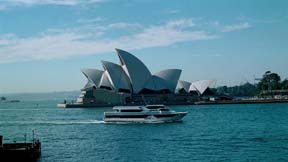
Thursday, May 16
We left at 5:45 am for the airport and were there in a taxi by 6:00 am, for the same A$28 (A$32 with tip, which we gather is really optional in Australia). We had no problem getting all our bags on Qantas, but I am worried about the small plane (19 seater, we hear) on Kendell Airlines from Adelaide to Ceduna, so have arranged to be met at ADL by a driver from Citicar, who will take two of our bags to the hotel in Adelaide to which we will go in three days.
Interestingly, Adelaide and Ceduna are in a time zone that is 1/2-hour earlier than that of Sydney, making it 13.5 hours later than NYC.
All those arrangements worked fine. The trip to ADL was smooth. The driver met us and took the bags. We went to the Kendell counter, which is still under a big sign with the defunct Ansett name. (When I asked if Kendell gave airline miles, the man said that they were under receivership [from bankruptcy] and that such niceties may be restored when someone takes over the airline.) We hear that we are allowed 15 kg each checked luggage, and kept ourselves to one 30 kg suitcase + a big camera bag + a computer case + a briefcase + (for Naomi) a large purse and a tote bag. The check-in person at Kendell preferred to check most things in and weighed everything, though he didn’t charge any overweight. I think for the small plane they just have to know the real weight. We are boarding carrying only (for me) the computer case + a single camera I extracted from my camera case and (for Naomi) her purse and her tote.
We waited in the Qantas Club, showing up at the gate 5 minutes before the boarding time we were given by Kendell, only to find that everybody else was already on board and that they were awaiting us. But the other people had only just gotten on board and the luggage was just arriving at the snazzy small plane, which seats about 19, one person on each side of the aisle. So there was no harm done. There was no room at all on the plane overhead for luggage, so I see why everything had to go in the hold. Indeed, they took half of the bags we still had and put them in the hold. I kept out only a single camera and a book and newspaper.
The 90-minute trip from ADL to CED went over some water and then a peninsula. Then we flew over clouds, and when we could see through the clouds we saw only barren fields–everything brown but divided into rectangles. Eventually we came in for a smooth landing down a runway that pointed at a town beyond, nicely visible through the cockpit front window.
At the airport, there are two competing rent-a-car companies, and we rented a small always-on four-wheel-drive cute red vehicle. Bevin, whose company this is, is apparently the largest local rental car person and has 60 vehicles. Last year, he supplied all the cars for the episodes of Survivor that were filmed not far from here. (T. Bevin, Ceduna Rent-a-Car, phone +61 8 8625 2085, fax +61 8 8625 2820, mobile +61 407 603 223, [email protected], PO Box 571, Ceduna SA 5690) There is also a Budget Rent-a-Car office, tel 08 8625 2742, fax 08 8625 3201.
We were met by the people whose house we have rented for the eclipse period. I will cover our very nice interactions with them in a private Weblog for my own group.
It is about 5 km to town from the airport. It is a charming town, with a cross of streets that has stores for about a block in each direction. A set of distance signs in the middle of the main intersection has notations like “Port Lincoln 414,” “Port Augusta 470,” “Adelaide 781” and “Perth 1964” (km). It is about a 7 hour drive from Adelaide. A look at the map shows that there are wide stretches of national parks and other restricted areas to the north of route A1, which goes from Adelaide to Perth. So there are literally no north-south roads. It would not be possible, once you are out on the road near Ceduna to drive north-south; only the east-west distance is available for eclipse chasing, so I think for this eclipse you have to pick a spot and be resigned to whatever weather you find.
Town has two supermarkets, a bakery with sit-down tables, two banks (I opened an account at ANZ to help with my eclipse expenses), a dry-cleaners, a laundromat, a hardware store, at least two appliance stores, and a clothing store. There are a few informal restaurants for take-out and sit-down, including a Chinese restaurant where we wound up having dinner. But all these facilities will be very overloaded during the eclipse. The Town Council has appointed a coordinator, Rob Curkpatrick, an Adelaide man who is experienced in arranging large events. They think there might be 20,000 or even 35,000 (I heard once) in this town of 3,500, so they are trying to make sure that food, sanitary facilities, and other arrangements are in place. I know little about the tent cities that are to be set up. Naomi and I meet with Rob in Adelaide on Monday, at which time I will learn more.
There is no internet cafe. I will ask Rob about arrangements for e-mail during eclipse time. I myself will use at least the dial-up of the people with whom we are staying. They are looking into the possibilities of installing a higher speed line. My Telstra Australian cell phone works fine, though there is also the possibility (likelihood?) of the circuits being overloaded at the eclipse period. I will suggest to Rob that he work with Telstra to temporarily beef up their wireless capabilities.
One block down from that main town intersection is the sea. There is a lovely park along the beach extending several blocks to either side, with a wharf extending straight out, due west (since Ceduna is on the east side of a bay). Everybody refers me to Rob to find out just what parts of this park will be restricted and what parts will be open to the public on eclipse day. Beyond the park are roads to the north and the south, so there is a lot of space along the roads where people can stop to see the eclipse. Note that it may be 40 degrees C (104 degrees F) or even more, so that it may be quite tough during eclipse day, and that I don’t know yet what sanitary facilities will be available. (We later saw that the record high temperature in December is 47 degrees C = 117 degrees F. But it could also be 25 degrees C = 77 degrees F for a daily high, which would be nice weather.)
The Thevenard neighborhood perhaps a kilometer to the south of downtown has a turnaround and a wood platform looking over the sea, and will also be wonderful for eclipse watching–though unable to handle all the people. I have heard that there may be tents near here–inland, off the shore. The view away from the shore is of a huge grain silo complex, which is also visible on the horizon from the shore near town.
We visited the Ceduna Tourist Center and met Margie Stott there (pronounced with a hard “g”), who is in charge. She handles housing, including home stays, and some small amount of that is still available. (telephone 1 800 639413 or +61 8 8625 2780, fax +61 8 8625 3294, [email protected], PO Box 757, Ceduna SA 5690) The eclipse watching details have been handed off to Rob. Some eclipse tee-shirts are already available in the center, which includes a travel agency, and local souvenirs like stuffed koalas are on sale. I forgot to inquire about internet facilities there (there is a sign on the window that indicates they are available), but plan to do so tomorrow.
We slept at the Highway One motel, on the outskirts of town, which makes it about 1/2 mile from the center of town. There is also a Best Western in town + one other motel. All, of course, are booked for the eclipse time.
Friday, May 17
We had breakfast at the Bakery downtown–muffins, pastries, bacon and eggs, etc. We met Phil Taylor by appointment; he is setting up a tent city for about 250 people at Thevenard Oval, that is, the football field out near Thevenard Point. He has a viewing area, which we visited, at Thevenard Point, a couple of kilometers east of the city along the coast. The people would walk or take a shuttle bus for about 5 blocks or so between the Oval and the viewing area. Phil’s e-mail is [email protected], mobile 0419 833 199.
We did some e-mail at the Visitor’s Center. They have only one computer there, so there will be total overload at eclipse week. I will mention that point to Rob, as well as suggest that he try to get Telstra, the telephone company, to bring more capacity for the cellular network.
I asked Phil whether it was true that the area around was so barren that there would be nothing to see if we drove for an hour or so in each direction. He disagreed, and suggested some trips. About an hour west is Cactus Beach, a surfing beach. Two or three hours away are some aboriginal rock drawings. While I was finishing my hour of e-mail, he had a business emergency, and Naomi and I drove up to Cactus Beach in our own 4wd. It was 70 km to Penong, the next town on the map, which turns out to be a crossroads with an old-style hotel that wasn’t serving any food, a BP gas station that had some cheap sandwiches, and a general store at which we wound up buying some cheese. It would have been nice if we had brought along utensils. We took the cheese and some toast we had down to the beach at Sinclair Point, another 20 km. For the last 5 km, we saw gypsum sand dunes and some low pools, both of which were pretty. At the beach turnoff, there is a small parking area and a modern wood set of beach boardwalk stairs. We could see a half dozen surfers in the water, and watched them occasionally catch a wave.
The drive took us across the beginning of the Nullarbor Plain, so named because there are literally no trees. Even in the first part of the drive, there were a few trees alongside the road, but basically none across the plains on all sides. For eclipse watching, though, there were broad shoulders on the two-lane road, and we could imagine people stopping their cars along the road. But it is hard to imagine how hard the conditions would be if it is 100 degrees Fahrenheit or even 90. People could die of dehydration. I myself would not go to the area unless I had accommodation with food and shelter reserved.
After the excursion, I concluded that I had been right at first–there is nothing to see on a drive an hour or so away from Ceduna.
Later in the afternoon, Mark Sood, my travel agent from Los Angeles, came into town with his local travel agent. Our tourist expedition, which is separate from my student/staff research trip, is listed at www.solareclipsetours.com. We have run tours together to India in 1980, India in 1995, Mongolia in 1997, Romania in 1999, and Zambia in 2001. We went together to see the site he has worked out for the group with Phil Taylor, an absolutely gorgeous site at the Shelley Beach campgrounds, which has 1 km of private coastline. The viewing will be from an area on top of dunes, with a pretty view over the sea one bay east of Ceduna. The tents they are setting up are just below. It would be nice if I could put my scientific equipment here, because of the unimpeded view, but it would be too hard, we think, to get sufficient electricity, shelter, etc., for the whole week prior to the eclipse that we need for setting up and aligning equipment. We are trying to make do at the house we have rented, but are checking to make sure that the sun is high enough at eclipse time to clear the trees that are between the house and the sea.
A weather front is coming in with rain, and we succeeded in changing our Kendell reservations from Sunday to tonight. Since we have seen everyone we wanted to see here, and have seen all the sights we wanted to see, we may as well have the rainy weekend in Adelaide. It wasn’t easy to change the Kendell tickets, which had to be done on the long-distance telephone. Even at the airport there was nobody with authority to change the tickets, since boarding at the tiny terminal is handled by the local travel agent at the Tourist Office. Kendell’s Australia telephone number from anywhere in Australia is 131300.
Here is the current Kendell schedule, but it is subject to change, and nothing is planned more than 3 months ahead because of the receivership:
Adelaide to Ceduna
KD 372 7:10am-8:40 am Tues, Friday
KD 372 10:35 am-12:10 pm Wed, Thurs
KD 374 6:10 pm-7:45 pm Sun, Mon, Tues, Fri
[there is no flight on Saturday]
Ceduna to Adelaide
KD 373 8:55 am-10:15am Tues, Fri
KD 373 12:25 pm-1:45 pm Wed, Thurs
KD 375 8:00pm-9:20pm Sun, Mon, Tues, Fri
One just has to be at the airport a half hour before the flight, and nobody is there before then. The plane is a 19-seater Saab propeller plane: 8 rows with one seat at each side of the aisle and a back row three across. The ceiling is so low that one can’t even stand up in the plane while boarding.
The trip from the airport to the Hilton in town was literally 10 minutes in a taxi.
Saturday, May 18
Adelaide is a planned city, set out in a grid in the mid-19th century. The square grid is surrounded by parkland on all sides, so the center city is quite compact and very walkable. The population listed in the guidebook is 1.7 million, but that obviously includes surrounding areas. Hotels are relatively cheap compared with Sydney or Melbourne.
Our hotel is on Victoria Square, a large area dead center in the planned grid. It is bounded by handsome 19th-century buildings. We walked up the broad King William Street to the north. Four blocks up to the right is a long shopping street, now a pedestrian mall, called Rundle Mall. Of it are all kinds of stores, and even two cinemas and an IMAX. We saw the new Star Wars, Episode 2, on a huge screen with stadium seating and a top-quality sound system.
Before and after the movie, we went one block farther north and saw the aboriginal artefact collection (the Australians and the British write “artefact” for what Americans write “artifact”) at the South Australian Museum. It is a fine collection, with thousands of spears, ornaments, masks, etc. The museum has recently been modernized, and the Australian aboriginal display has been nicely and carefully updated and mounted. The Pacific Island artefact collection, by contrast, is in a rather more old-fashioned set of museum surroundings. The Mundrabilla meteorite, 2500 kg (out of the original 5000 kg), collected in the Nullarbor Plain, is at the museum’s entrance, and other meteorites are upstairs. Tomorrow we plan to go to the South Australian Art Gallery. We stopped into the adjacent South Australian Library, and briefly looked at the only exhibition there–one about the famous cricketeer Don Bradman. For those in cricket countries, he is more famous than Babe Ruth is in the U.S.A., I am told.
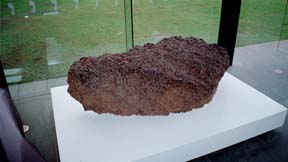
We tried hard to get an International Herald Tribune, but it is just not available anywhere in Adelaide.
But in Adelaide–and, indeed, in Ceduna–there is lots of Kodak film of all types. (The price at the Ceduna tourist office for Kodak Elite Chrome is A$10.50 for 24 exposures and is A$8.40 for a roll of Gold 100 24-exposure and A$13.20 for a pack of two rolls; there were no 36-exposure rolls there, though the Adelaide airport had had them.) So part of the solution to the debate we have been having on line on the Solar Eclipse Mailing List of how to safeguard your film when passing through airports may be simply to purchase the film in Australia, saving at least half the exposures.
Sunday, May 19
Early on, we went for a long walk around this planned city, up to and including the lush botanical gardens. We covered much of our ground during intervals in the rain, which recurred at intervals. We moved our hotel from the Hilton to the Hyatt. At noon, we went for a drive in the Barossa Valley wine country with Mark and Lisa, including a wine tasting and ploughman’s lunch at the Peter Lehmann establishment. Later, we had coffee/tea/chocolate at the old German town of Hahndorf–very touristy town but nice. Back home, we enjoyed the buffet dinner at the Hyatt.
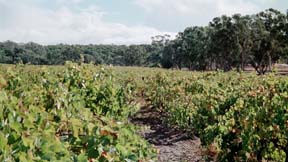
At the Hilton, I could use the business center at A$10/hour for their dial-up line. At the Hyatt, I have a high-speed Ethernet link in my room for A$30/day maximum (A$1.65 per three minutes). The line started up fine but crashed after 20 min. After the hotel personnel fixed it once, apparently by restarting the program, it went dead more definitively. Finally, someone on the phone from Singapore (!) monitored the line and saw it go off and on quickly. He figured out that the Ethernet plug may not be tightly into the wall socket; that’s the end of the wire that I didn’t touch. He was right, and the connection has worked reliably since then on my Macintosh G4 titanium PowerBook.
Monday, May 20
At 9 a.m., after a walk along the riverbank, we met, by arrangement, Rob Curkpatrick for breakfast at the Hyatt. He is a professional event coordinator, and has been hired by Ceduna to arrange various eclipse-related events, including the allotment of space in Ceduna. We were joined by three members of the Astronomical Society of South Australia, an active amateur group: Fraser Farrell, Michael Mattiazzo, and Tony Beresford.
Rob hadn’t realized that an 88% partial eclipse, which they will have in Adelaide, is like nothing compared with a total eclipse, a fact reinforced by the agreement by the ASSA trio with my evaluation. So that alone made our meeting worthwhile, since he will be coordinating publicity in Adelaide. Also, I gave him a corrected version the writeup, distributed in the Tourist Office at Ceduna, about how to watch the eclipse, with dire and sometimes incorrect eye-protection discussions, and he accepted it gracefully and said he would incorporate the changes. Rob was very pleased that the advice we offer from the Working Group on Eclipses of the International Astronomical Union comes free of charge; he is more used to working with, say, professional motoring organizations, which charge for everything. He thinks he can set aside a patch of seafront opposite the Wade house for our professional group to carry out our experiments, and to get an electric line from a nearby house in the old-age development. He thinks we may need a generator to stand by. We already plan to use UPS’s, something that Fraser is looking into; he is in the computer consulting business. We were joined by Stuart Innes, a journalist from The Advertiser, one of the Adelaide newspapers [email protected]), and a photographer. There may be something about the eclipse in tomorrow’s edition. Our meeting lasted 2.5 hours and we covered lots of ground. Rob will look at various information pieces on our www.eclipses.info Web site, including Ralph Chou’s information about safe filters.
They are planning some festival at Ceduna on eclipse day. At present, the loud music will stop two hours prior to totality, though I asked for longer quiet time. After totality they will have various activities leading up to fireworks. They may play the symphony Star Chant mentioned above at some time during the day.
Fraser took us about an hour south on the Fleurieu peninsula, where we took a walk in the bush. We then had lunch in his home town of McLaren Vale at a modern restaurant attached to a local hotel. We declined a wine tasting in an adjacent winery but we did drive through scenic wine country to a chocolate factory. The roads also gave us beautiful views over the ocean. Fraser took us to meet Michael O’Leary, a former Navy navigator, who teaches navigation and a bit of astronomy at the University’s planetarium. The members of the Astronomical Society of South Australia will be a valuable resource for the local people in the months leading up to the eclipse. We had dinner at our hotel after a long day.
Tuesday, May 21
We began the day by visiting Ayers House, the major house in town (on North Terrace, opposite the museums) of Sir Henry Ayres, of Ayres Rock fame. He made a fortune in the 1850s-70s in mining. The house is worth the tour. We visited the Art Gallery of South Australia, which has major collections of European art and of Australian art. It should be on everyone’s activity.
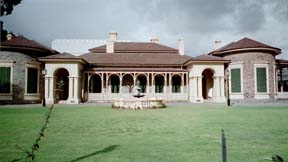
We visited Prof. Roger Clay, head of the Department of Physics of the University of Adelaide, a cosmic-ray high-energy astrophysicist. They have no particular plans to observe the eclipse, other than personally travelling to see it.
The University of Adelaide was the site of Prof. AW. H. Bragg’s first teaching, and there is a laboratory named after him. We saw some of the early physics equipment on display.
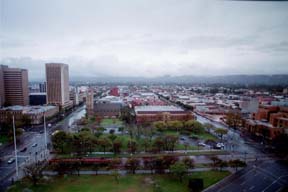
At 5 pm, we flew to Melbourne on Qantas.
Wednesday and Thursday in Melbourne
Wednesday, May 22
We spent the day walking around Melbourne, a lively city filled with shops and people. We are really back in the Big City. We had been looking forward to seeing the major art collection at the Art Gallery of Victoria, but their main building on the south bank of the river is closed for two years for major renovation, and the remnants of the collection on display in a building on Russell Street in town are disappointing. We also saw beautiful watercolors of the genus Banksia, plants, on display at the National Library.
Melbourne is a city filled with skyscrapers, and one walks among them.
We were exhausted by mid-afternoon, and sat quietly for 3 hours watching “The Fellowship of the Ring.” At least there was THX sound, but the movie itself was much worse than we had expected, especially the second half.
Friday aloft to fly home: MEL-LAX-BOS.
Back to Total Solar Eclipse on December 4, 2002 at Australia
